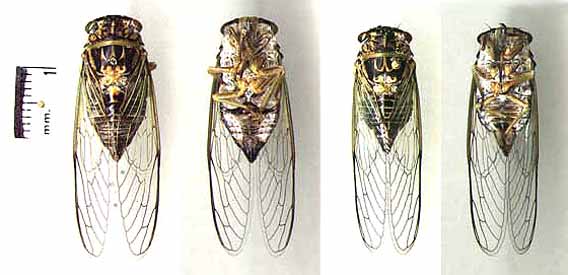
The University Of Michigan
Cicadas of Michigan
Page
About Cicadas:
Cicadas are insects belonging to the family Cicadidae in the order Hemiptera*. Cicadas are recognizable by their large size (>1 inch) and clear wings held rooflike over the abdomen. Most cicadas are strong fliers that spend their time high in the trees, so they are rarely seen or captured. Their life cycles are long, usually involving multiple years spent underground as juveniles, followed by a brief (roughly 2-6 weeks) adult life above ground. As juveniles and adults, they feed on the xylem fluid of woody plants using piercing and sucking mouthparts. As adults, males produce a loud species-specific mate-attracting song using specialized sound-producing organs called tymbals. These sounds are among the loudest produced by any insects. In some species, the male calling song attracts both males and females to mating aggregations, while in other species males remain dispersed. Female cicadas do not have tymbals, but in some species the females produce clicking or snapping sounds with their wings. After mating, females lay eggs in bark or twigs; the eggs hatch later in the season and the new nymphs burrow underground and begin feeding on roots.
* (note that, as a result of recent molecular phylogenetic studies, the "order Homoptera" is now being recognized as a paraphyletic assemblage within the order Hemiptera).
About This Page:
This page illustrates the ten cicada species known from the state of Michigan. The pictures show (from left to right) male dorsal view, male ventral view, female dorsal view, and female ventral view. The scale in the photographs is 1 cm long. Click below each picture to hear male calling songs of each species [8-bit 22kHz AIFF or WAV]. We have provided whole calling songs when possible; species with very long repetitive songs are represented by a smaller fragment to keep the file size manageable. Also keep in mind that insect sounds vary with temperature, particularly in temporal qualities. See the Diceroprocta vitripennis and Tibicen linnei calling song samples below for examples of temperature effect.
Identification:
You can scroll down this page to identify a cicada specimen, or you can click here to use modified versions of the dichotomous identification keys included in Alexander et al. (1972).
The photographs, sound files, and keys in this web resource cannot be considered to be a substitute for the opinion of a trained entomologist; they should be used for tentative identification only. No two specimens of a species are identical, and variation in cicadas of such characters as coloration patterns and size can be substantial.
Note: The cicadas featured on this page have wide distributions, with geographic variation in song and appearance. Some of the songs and specimens on this page were obtained from outside the state of Michigan and thus may differ slightly from typical Michigan specimens, although any such differences are unlikely to cause confusion among these species. Colors (especially green) may not be accurate, due to the photographic process used and the state of preservation of the museum specimens.
[ Diceroprocta vitripennis ] [ Magicicada septendecim ] [ Okanagana canadensis ] [ Okanagana rimosa ] [ Tibicen auletes ] [ Tibicen canicularis ] [ Tibicen tibicen ] [ Tibicen linnei ] [ Tibicen lyricen ] [ Tibicen pruinosus ] [ To contact us ] [ For further reading. . . ]
Genus Diceroprocta
Cicadas belonging to the genus Diceroprocta are medium-sized with greenish wing veins. Only one species of this genus is known in Michigan; it is found in the southwestern portion of the state.

Calling song fragment
Genus Magicicada
The genus Magicicada contains the periodical cicadas, known for their 17- or 13-year synchronized life cycles and dense choruses. These cicadas have striking black bodies, red eyes, and red wing veins. Six species are described from this group, but only one is known to exist in Michigan. Males and females join dense aggregations, or leks, where the males search for the stationary females using short flights and calls.
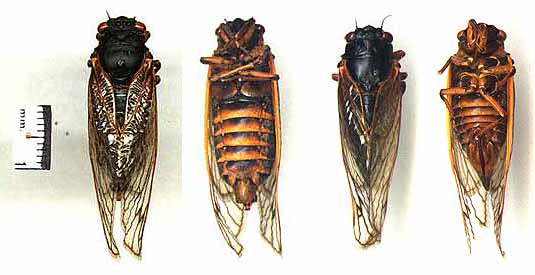
Magicicada septendecim songs:
|
Chorus (297K) | ||
|
Calling song / Court I, chorus in background (132K) | ||
|
Court II (85K-fragment) | ||
|
Court III with chorus (77K-fragment) |
Visit the UMMZ Periodical Cicada Web Site for in-depth information on this remarkable group of cicadas.
Genus Okanagana
In Michigan, Okanagana are medium-sized, dark-bodied cicadas that are sometimes confused with periodical cicadas. They are usually found in small numbers, but in some years much denser populations emerge. Individual males tend to call from a single location for long periods of time; females approach the males directly for mating.
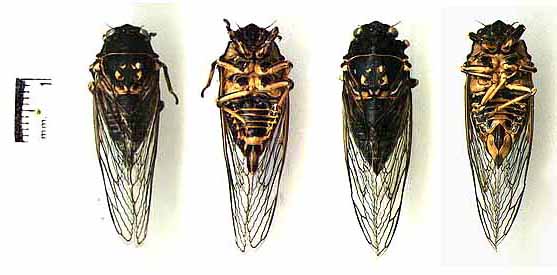
Calling song fragment
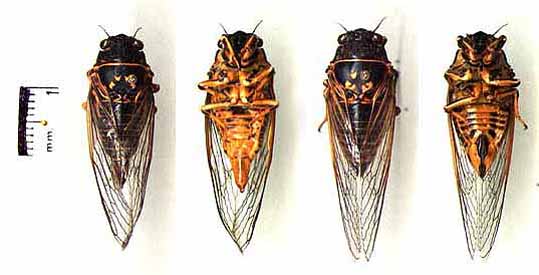
Calling song fragment
Genus Tibicen
Cicadas belonging to the genus Tibicen are large-bodied cicadas, usually with green and brown markings. These are the "dog day" cicadas of late summer and fall. In Michigan they tend to be found alone or in small numbers, only rarely in denser aggregations.

Calling song
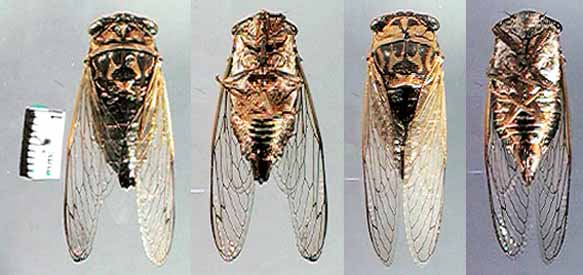
Calling song
Tibicen tibicen [= Tibicen chloromerus (Walker, 1850)]
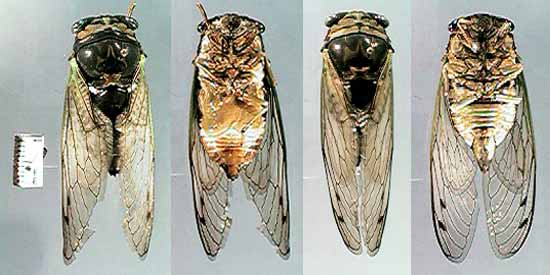
Calling song
Note that the name Tibicen tibicen has recently been discovered to have precedence over T. chloromera/chloromerus: see Sanborn, A., 2008, Entomological News 119(3): 227-231.
Tibicen linnei (Smith and Grossbeck)
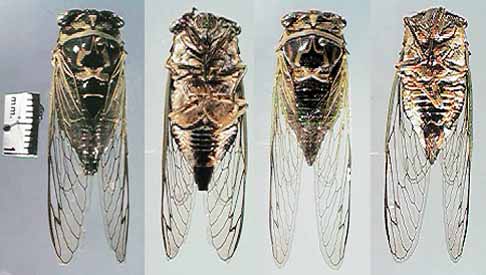
Calling song
Calling song
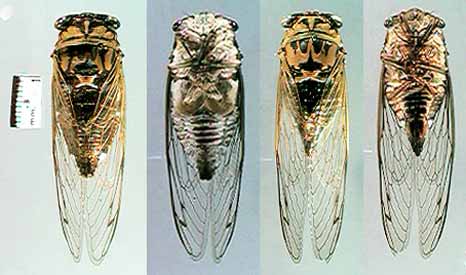
Calling song
Alexander, R. D., A. E. Pace and D. Otte. 1972. The singing insects of Michigan. Great Lakes Entomol. 5:33-69.
Marshall, D. C., J. R. Cooley, R. D. Alexander, and T. E. Moore 1996. New records of Michigan cicadidae (Homoptera), with notes on the use of songs to monitor range changes. Great Lakes Entomol. 29: 165- 169.
Moore, T. E. 1966. The cicadas of Michigan. Papers of the Michigan Academy of Science, Arts, and Letters 51: 75- 94.
Click here for a list of cicada literature
Web-based monitoring of periodical cicada brood distributions is ongoing at John Cooley's www.magicicada.org site.
For song recordings of cicadas of the United States and Canada, go to the InsectSingers.com site. Content on
eastern cicadas is here, and some western cicada songs are here.
To learn about cicadas of New England, check
out the comprehensive Cicadas of Massachusetts page, constructed by Gerry Bunker.
To learn about other cicadas of the Mid-Atlantic region, check
out John Zyla's excellent Cicadas.info page.
Dan Century's Cicada Mania page is an excellent general cicada site with photo
galleries and numerous links to other cicada websites.
Chris Simon's Cicada
Central site at The University of
Connecticut is an extensive cicada resource including pages on Periodical
Cicadas, New Zealand Cicadas, and a web-searchable Magicicada specimen database. This site also
contains brood maps with distributions shown as county-level records.
Email:
U. S. Postal Service:
John Cooley
Ecology & Evolutionary Biology
University of Connecticut
75 North Eagleville Road, U-43
Storrs CT 06269
David Marshall
Ecology & Evolutionary Biology
University of Connecticut
75 North Eagleville Road, U-43
Storrs CT 06269
Return to UMMZ Cicada pages index
Keywords: cicada, cicadas, Cicadidae, Homoptera, Michigan, Harvestfly, Dog-Day Cicadas.